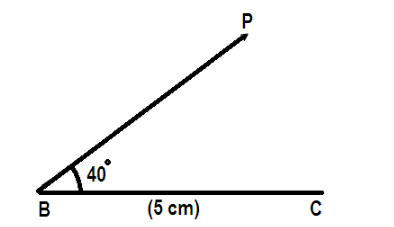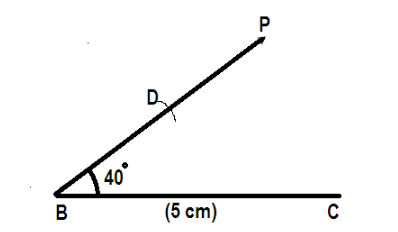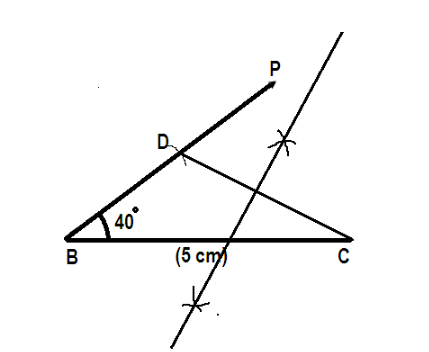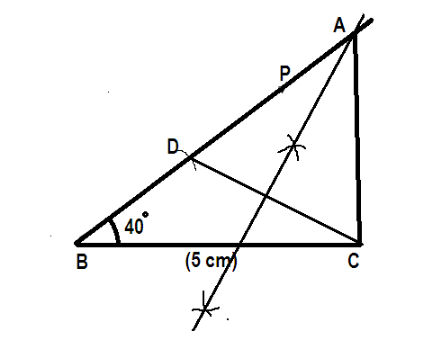Answer
397.2k+ views
Hint: A triangle is a three sided quadrilateral and to construct a triangle one needs to draw a line segment and suppose it to be the base of the triangle. To construct a triangle one needs a protractor or a compass, a ruled scale.
Complete step-by-step answer:
Since we have been given the length of a line segment BC as 5 cm. let us draw a line segment BC using the ruler and suppose it to be the base of the triangle.

We have the measure of angle B, therefore using the protractor we will make the $ \angle PBC $ of measure equal to the $ \angle B = {40^ \circ } $ and extend the ray .

Now from the ray AP cut off the line segment BD equal to ‘l’ which is the given difference of AB- AC = 2.8 cm. Stretch your compass 2.8 cm and put the needle of the compass at B cut off BD from the ray AP.

Now join C and D. Construct the perpendicular bisector of CD meeting BP at C where the perpendicular bisector is drawn by drawing an arc on both the sides of DP with the help of compass taking C and D as centres.

Now extend the ray BP such that it meets the perpendicular bisector at the point A and then join A and C to draw the complete triangle ABC.

Hence this is the triangle constructed.
Note: Carefully make the perpendicular bisector of CD with the help of the compass, perpendicular bisector is basically the line which bisects the given line segment and is perpendicular to that particular line segment.
Complete step-by-step answer:
Since we have been given the length of a line segment BC as 5 cm. let us draw a line segment BC using the ruler and suppose it to be the base of the triangle.

We have the measure of angle B, therefore using the protractor we will make the $ \angle PBC $ of measure equal to the $ \angle B = {40^ \circ } $ and extend the ray .

Now from the ray AP cut off the line segment BD equal to ‘l’ which is the given difference of AB- AC = 2.8 cm. Stretch your compass 2.8 cm and put the needle of the compass at B cut off BD from the ray AP.

Now join C and D. Construct the perpendicular bisector of CD meeting BP at C where the perpendicular bisector is drawn by drawing an arc on both the sides of DP with the help of compass taking C and D as centres.

Now extend the ray BP such that it meets the perpendicular bisector at the point A and then join A and C to draw the complete triangle ABC.

Hence this is the triangle constructed.
Note: Carefully make the perpendicular bisector of CD with the help of the compass, perpendicular bisector is basically the line which bisects the given line segment and is perpendicular to that particular line segment.
Recently Updated Pages
How many sigma and pi bonds are present in HCequiv class 11 chemistry CBSE

Why Are Noble Gases NonReactive class 11 chemistry CBSE

Let X and Y be the sets of all positive divisors of class 11 maths CBSE

Let x and y be 2 real numbers which satisfy the equations class 11 maths CBSE

Let x 4log 2sqrt 9k 1 + 7 and y dfrac132log 2sqrt5 class 11 maths CBSE

Let x22ax+b20 and x22bx+a20 be two equations Then the class 11 maths CBSE

Trending doubts
Fill the blanks with the suitable prepositions 1 The class 9 english CBSE

At which age domestication of animals started A Neolithic class 11 social science CBSE

Which are the Top 10 Largest Countries of the World?

Give 10 examples for herbs , shrubs , climbers , creepers

Difference between Prokaryotic cell and Eukaryotic class 11 biology CBSE

Difference Between Plant Cell and Animal Cell

Write a letter to the principal requesting him to grant class 10 english CBSE

Change the following sentences into negative and interrogative class 10 english CBSE

Fill in the blanks A 1 lakh ten thousand B 1 million class 9 maths CBSE



